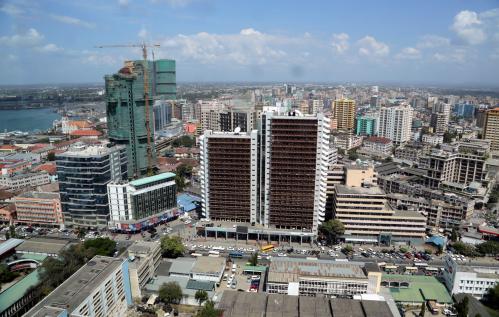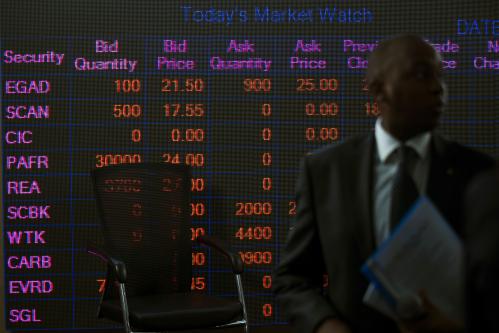African debt is increasing—this is an indisputable fact. Indeed, sub-Saharan Africa is rapidly approaching debt levels reminiscent of the era just before the Multilateral Debt Relief Initiative (MDRI) for outright forgiveness of debt owed by a group of 36 low-income countries, and the Heavily Indebted Poor Countries (HIPC) initiative instituted in 1996 to address debt overhang in the poorest countries of the world.
In light of this rapid rise, on April 12, the Africa Growth Initiative hosted a panel discussion moderated by Senior Fellow and Director Brahima S. Coulibaly, “Is sub-Saharan Africa facing another systemic debt crisis?”
He was joined by Hon. Mthuli Ncube, minister of finance and economic development for Zimbabwe; Ms. Trang Nguyen, executive director, emerging market sovereign credit strategy at J.P. Morgan; Dr. Sean Nolan, deputy director of the strategy, policy, and review department at the International Monetary Fund; and Dr. Vera Songwe, executive secretary of the United Nations Economic Commission for Africa and a nonresident senior fellow at the Brookings Africa Growth Initiative.
Coulibaly began the discussion with a basic question: Is Africa facing another systemic debt crisis?
Unsurprisingly, the answer seems to be more complicated. Nolan and Ncube began their remarks by emphasizing the diversity of the region when it comes to debt: The rising issue might not be continent-wide, but, rather, is concentrated in a select group of countries. Nguyen agreed, but posited that markets aren’t seeing the challenge that way. In the way that markets price bonds, she said, there just is not enough differentiation among the countries.
Nguyen stated that, while a debt crisis is not imminent, risks are building up. She warned, “I think it’s also important for the issuers—the authorities—to be very mindful of the role of benchmark investing as well because sub-Saharan Africa is going to be quite vulnerable to any bouts of risk aversion to the extent that we have tighter financial conditions that demand for higher-yielding debt for riskier assets does decline, there’s a good chance that we may see capital being pulled out of emerging markets, and that will affect the region as a whole, and the selling could occur at a very indiscriminate manner.”
Songwe agreed that the problem is not continent-wide, but also took a different line, stating that the crisis is not a debt one, but rather a governance one, pointing out that the countries in or close to debt distress are resource-rich or fragile states.
In addition, Songwe did not dismiss commodity-backed loans, but rather emphasized the need for good governance around them, saying, that well-structured loans create a “smoother financing environment for both the investor and the investee.”
Ncube noted that while Africa is not facing a debt crisis now, that’s not to say it won’t in the future, opening up another major theme of the discussion, also echoed in the recent policy brief: the changing composition of African debt. Unlike during the HIPC era when the majority of debt was held by the Paris Club countries and the multilaterals, non-traditional donors and commercial lenders have increased in prominence, meaning restructuring and forgiving that debt will be much more complex and difficult if it needs to be done.
Ncube stressed this point, saying, “This time is different because the last time once just before the HIPC exercise, countries in Africa were growing at an average rate of three percent per annum. This time they can service concessional loans only that they just have too much in commercial loans for which they’re paying average interest rates of 7 percent; and for those growing below the 7 percent, then they’re in trouble.”
Nolan emphasized that this new lineup of creditors will cause debt restructuring to become more complex, as actors like India, China, and the Gulf states, for example, don’t have business models that involve default. Nolan also called upon the need for traditional partners to be involved in discussions on the rising debt levels, and to assist in prioritization and choice of public investments.
Despite these challenges and in light of positive posited solutions, one of the most hopeful notes of the discussion came from Songwe. She noted that debt can be a good thing when used wisely: “And the final point on all of that is really about leadership and transparency and efficiency in the investment. Debt is good if out of Senegal you’re taking debt to build a better road; build a toll road that is going to pay you back; and get more energy that is going to make you more competitive. So, debt, in itself, is a good idea. Nobody can grow without debt. The issue is what is the efficiency of that debt; and what is the use for that debt.”
The discussion ended with recommendations from each panelist. Nguyen made a call for better data so investors can better do their homework on the region and advised countries to understand their investor base. Songwe re-emphasized her point on instating discipline in government policies, especially around state-owned enterprises. Ncube repeated Nguyen’s call for better data, adding that he would like to see increased debt management capacity in the government. He also stated that policymakers need to move to a government balance sheet approach. Nolan restated his recommendation that development partners actively engage these governments through technical assistance.






Commentary
A conversation on sub-Saharan Africa’s debt situation
April 23, 2019